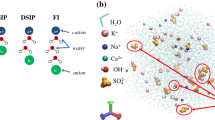Abstract
In this paper we investigate the non-linear binding effects upon the diffusion–migration test. For the diffusion test we derive the conditions required for the non-linear binding isotherm to produce an actual penetration front. When more than two ion species are present we show that the diffusion coefficient associated with a particular ion cannot be extracted from the diffusion test on account of multi-species electrical effects. In the migration test where an external electrical field is applied to the sample, we give the conditions required for the propagation of a stable ‘travelling wave’. In addition new explicit expressions of the time-lag are obtained for both tests, allowing the determination of the properties of the unknown binding isotherm whatever its physical nature. Throughout the paper the results and the method are illustrated by the diffusion of the Cl− ion within cement-based materials, using experimental data extracted from literature. The theoretical predictions compare well to these experimental data.
Similar content being viewed by others
References
Alshawabkeh, A. N. and Acar, Y. B.: March 1996, Electrokinetic remediation, II: theoretical model, J. Geotech. Eng. 186–196.
Andrade, C.: 1993, Calculation of chloride diffusion coefficients in concrete from ionic migration measurements, Cem. Concr. Res. 23(3), 724–742.
Bigas, J.-P.: 1994, Diffusion of chloride ions in mortar, PhD Thesis (in French), G´enie civil – INSA Toulouse.
Bigas, J.-P., Lambert, F. and Ollivier, J.-P.: 1996, Overall modelling of physico-chemical interactions governed by non-linear isotherms between chloride ions and cement Portland mortar (in French), Mater. Struct. 29, 277–285.
Castellote, M., Andrade, C. and Alonso, C.: 1999, Chloride-binding isotherms in concrete submitted to non-steady migration experiments, Cem. Concr. Res. 29, 1799–1806.
Castellote, M., Andrade, C. and Alonso, C.: 2001, Measurement of the steady state and non steady state diffusion coefficients in a migration test by means of monitoring the conductivity in the anolyte chamber. Comparison with natural diffusion tests, Cem. Concr. Res. 31, 1411–1420.
Coussy, O.: 1995, Mechanics of Porous Continua, Wiley.
Crank, J.: 1995, The Mathematics of Diffusion, Oxford Science Publications.
Francy, O.: 1998, Modelling of the penetration of chloride ions in mortar partially water saturated, PhD Thesis (in French), G´enie civil – INSA Toulouse.
Hausmann, D. A.: 1967, Steel corrosion in concrete: how does it occur? Mater. Prot. 4(11), 19.
Keister, J. C. and Kasting, G. B.: 1986, Ionic mass transport through a homogeneous membrane in the presence of a uniform electric field, J. Membr. Sci. 29, 155–167.
Logan, D. J.: 2000, Transport modeling in hydrogeochemical systems, Interdisciplinary Applied Mathematics, Vol. 15, Springer.
Mainguy, M. and Coussy, O.: 2000, Propagation fronts during calcium leaching and chloride penetration, J. Eng. Mech., ASCE 126(3), 250.
Mainguy, M., Ulm, F.-J. and Heukamp, F. H.: 2001, Similarity properties of demineralization and degradation of cracked porous media, Int. J. Solids Struct. 38, 7079–7100.
Murphie, W. E.: 1992, Decommissioning of radioactive facilities, in: Proceedings of the International Conference. Institution of Mechanical Engineers, London, United Kingdom, p. 9.
Page, C. L. and Treadaway, K. W. J.: 1982, Aspects of the electrochemistry of steel in concrete, Nature 297(5), 109.
Paul, D. R.: 1969,J. Polym. Sci. A2(7) 1811 (cited in Crank, 1995).
Reyes, S. C., Sinfelt, J. H. and DeMartin, G. J.: 2000, Diffusion in porous solids: the parallel contribution of gas and surface diffusion processes in pores extending from the mesoporous region into the microporous region, J. Phys. Chem. B. 104(24), 5750–5761.
Tang, L. and Nilsson, L. O.: 1993, Chloride binding capacity and binding isotherms of OPC pastes and mortars, Cem. Concr. Res. 23, 247–253.
Travis, C. C. and Etnier, E. L.: 1981, A survey of sorption relationships for reactive solutes in soil, J. Environ. Qual. 10(1), 8.
Truc, O., Ollivier, J.-P. and Carcassés, L. M.: 2000a, A new way for determining the chloride diffusion coefficient in concrete from steady state migration test, Cem. Concr. Res. 30, 217–226.
Truc, O., Ollivier, J.-P. and Nilsson, L. O.: 2000b, Numerical simulation of multi-species diffusion, Mater. Struct. 33, 566–573.
Van Duijn, C. J., Grundy, R. E. and Dawson, C. N.: 1997, Large time profiles in reactive solute transport, Transport in Porous Media 27, 57.
Author information
Authors and Affiliations
Rights and permissions
About this article
Cite this article
Coussy, O., Eymard, R. Non-Linear Binding and the Diffusion–Migration Test. Transport in Porous Media 53, 51–74 (2003). https://doi.org/10.1023/A:1023529906079
Issue Date:
DOI: https://doi.org/10.1023/A:1023529906079




